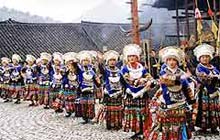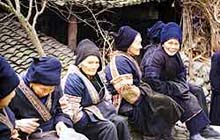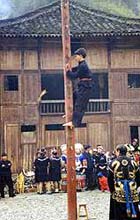
This article by Imperial Tours' founder about the tribes of Guizhou is for cultural informational purposes only. Imperial Tours does not offer services to these destinations as luxury faciltiies are not available.
By Guy Rubin
 As cranes and bulldozers proliferate like ants across China, depositing cities and highways in their hammering trail, now is the time to venture inland in search of the more traditional side of China. In a vast crescent of land, curving from Guilin's moonscape through the jungles of Xishuangbanna to the Tibetan plateau in the north west, reside many of China's ethnic minorities. From the Dong to the Yi to the Bai, each minority, with its own distinct lifestyle, culture and mythology embodies a unique and refreshing vision of the world.
As cranes and bulldozers proliferate like ants across China, depositing cities and highways in their hammering trail, now is the time to venture inland in search of the more traditional side of China. In a vast crescent of land, curving from Guilin's moonscape through the jungles of Xishuangbanna to the Tibetan plateau in the north west, reside many of China's ethnic minorities. From the Dong to the Yi to the Bai, each minority, with its own distinct lifestyle, culture and mythology embodies a unique and refreshing vision of the world.
North-west of Guilin, Guizhou, a rarely visited, landlocked province is an anthropoligical treasure trove. Its poor farmland and geography, discouraging the interest of powerful neighbours, are home to 13 of China's 60 officially recognized ethnic minorities. The tawdry provincial capital of Kaili, a five hour train ride east of Guiyang, provides a good base for explorations of the surrounding Miao villages.
Courtship, Miao style
 On our arrival at Langde, south-west of Kaili, visitors were already being conducted into the village to participate in its New Year festival. At each turn in the zig-zagging path that climbed to the hillside village's stone portal, children and beautifully bedecked local women were on hand to offer celadon-colored cups of the local wine. Their heads held rigid beneath ornate silver head-dresses, their bodies delicately poised in intricately embroidered, traditional costumes, they appeared like guardian angels at the gates of heaven. As I tipped one of the proffered ceramic cups back, glancing beyond its dark outer rim at the silver-framed, smiling child before me, I wondered how long this idyllic custom might continue.
On our arrival at Langde, south-west of Kaili, visitors were already being conducted into the village to participate in its New Year festival. At each turn in the zig-zagging path that climbed to the hillside village's stone portal, children and beautifully bedecked local women were on hand to offer celadon-colored cups of the local wine. Their heads held rigid beneath ornate silver head-dresses, their bodies delicately poised in intricately embroidered, traditional costumes, they appeared like guardian angels at the gates of heaven. As I tipped one of the proffered ceramic cups back, glancing beyond its dark outer rim at the silver-framed, smiling child before me, I wondered how long this idyllic custom might continue.
My thoughts were interrupted by the warbling notes of lusheng pipes emanating from the stilted wooden homes. These hand-held, reed pipes, used by the Miao minority, have become the generic term for their courtship festivals. We hurried towards the music's source; its wavering melody, enlivening the still, damp air, teased us through the village's labyrinthine, stone-paved pathways. Skirting a moss-covered pond with a breath-taking view over the river, we eventually arrived at the main square.
Stepping onto the "Flower Ground", also translated as the "choosing a lover ground", we were overwhelmed by the bustling activity before us. This cobble-stone patterned courtyard, tucked in on three sides by beautiful, tiled houses and overlooking a low valley on the fourth, was a kaleidoscope of color and sound.
 Dozens of elaborately clad girls and uniformed boys were crowding around each other. At a resolute, booming signal from a large bronze drum, the elderly folk, wearing dark robes with embroidered sleeves, guided their grand-children (ethnic minorities are exempt from the one child policy) to a nearby stone wall, clearing the square. They chattered amongst themselves as the boys, once more playing the lusheng pipes, led the girls through a delicate, shuffling dance of graceful bows and dainty hops.
Dozens of elaborately clad girls and uniformed boys were crowding around each other. At a resolute, booming signal from a large bronze drum, the elderly folk, wearing dark robes with embroidered sleeves, guided their grand-children (ethnic minorities are exempt from the one child policy) to a nearby stone wall, clearing the square. They chattered amongst themselves as the boys, once more playing the lusheng pipes, led the girls through a delicate, shuffling dance of graceful bows and dainty hops.
Although the mood is gay and the occasion light-hearted, there is little aimlessness about these courtship activities. Their goal is to bring together boys and girls of marriageable age for matchmaking. If a particular boy's looks and dancing make some maiden's heart palpitate and her knees go wobbly, tradition dictates that she should place a ribbon around his neck. If the boy is similarly smitten, he may show his interest by returning the talisman to her later in the day.
It appeared that the greatest risk to any ensuing relationship stemmed from the macho stunts the boys perform at the end of the festival to prove their mettle. Having walked across hot coals and lain on a bed of nails, one brave Miao youngster approached the tall pole in the center of the square. During the subsequent drum-roll, we noticed that the rungs punctured into this pole were actually comprised of up-turned, dagger blades – which the boy now circumspectly ascended. A villager informed us that the trick to doing this consists in not nudging your hands or feet sideways as you lay them on the blades. And if you do? In response, our interlocutor resignedly shrugged his shoulders.
As we were ambling out of this picture-book village, serenaded by the lilting tune of the pipes, we were loathe to acknowledge the undeniable influences of the modern world on this age-old festival. On a superficial level, many of the elaborate head dresses, used to differentiate women from various villages, were being replaced by a tacky assembly of bath towels held in check by plastic combs. More significantly perhaps, we observed a marked absence of young men in the crowd. A villager confirmed that many had left for the towns in search of work. The farms were barely surviving, he claimed, only kept going by the irregular remittances of these migrant workers.
An Inter-Village Bull-Fight
The very next day however, we drove by a terraced hill bedecked with such young men and their bulls. Leaping out of our minibus, we rushed past food stalls to see what was going on. It was an inter-village bull-fighting competition. And it was being conducted in deadly earnestness. While the men huddled excitedly around the bull-fighting ground, women and children sat disinterested, high on the hill.
Unlike their Spanish equivalent, these bullfights do not pit man against beast, but bull against bull. Having been drawn opposite each other, metal-tipped horn to metal-tipped horn, their oil-rubbed flanks glistening under the low, flat skies, it is a matter of seconds before the bulls' heads lower and, with a crack, they aggressively ram each other. With their horns locked and their muzzles scraping along the kicked up turf, the bulls embark on a titanic struggle. Since each bull's character is as varied as its physique, every fight, incorporating different fighting strategies, is absorbingly unique – the winner being decided in one of two ways. Either a team of judges selects a champion or else every so often one of the bulls flees, often into the nearby crowd, scattering exhilarated onlookers in all directions.
In the excited tension, articulated on every male face in the valley, there was no doubting the enduring fascination and enjoyment of this entertainment.
Ethnic Opera
More surprising perhaps, given the general disinterest of city dwellers, is the popularity of "dixi" or ground opera at a Bouyei village we visited. This local strain is derived from Han opera, brought to the region by soldiers from Nanjing during the Ming dynasty.
Glamorously dressed singers were surrounded by the whole village, who sat enraptured for the whole of the five hour performance. In fact, so enthusiastic was their reception, that the singers were called upon to repeat favorite arias for different sections of the crowd. For us, nonaficionados, it was as fun to watch the antics of the audience and chat with the villagers as it was to listen to the opera.
Guizhou's relative poverty continues to shield its indigenous peoples from the encroachment of China's predominantly coastal consumerism. Those travellers prepared to venture far from Guizhou's main roads can still be rewarded with cultures who seem to have escaped the claws of time. As the incipient Chinese tourist industry gathers momentum however, expect the innocent spirit of these fragile societies to be compromised by the easy lure of the tourist dollar.
For more information, pick up a copy of "Guizhou, Southwest China's Mountain Province," by Gina Corrigan (Passport Books, ISBN I 0-8442-9896-4)
July 2000, Chinanow.com